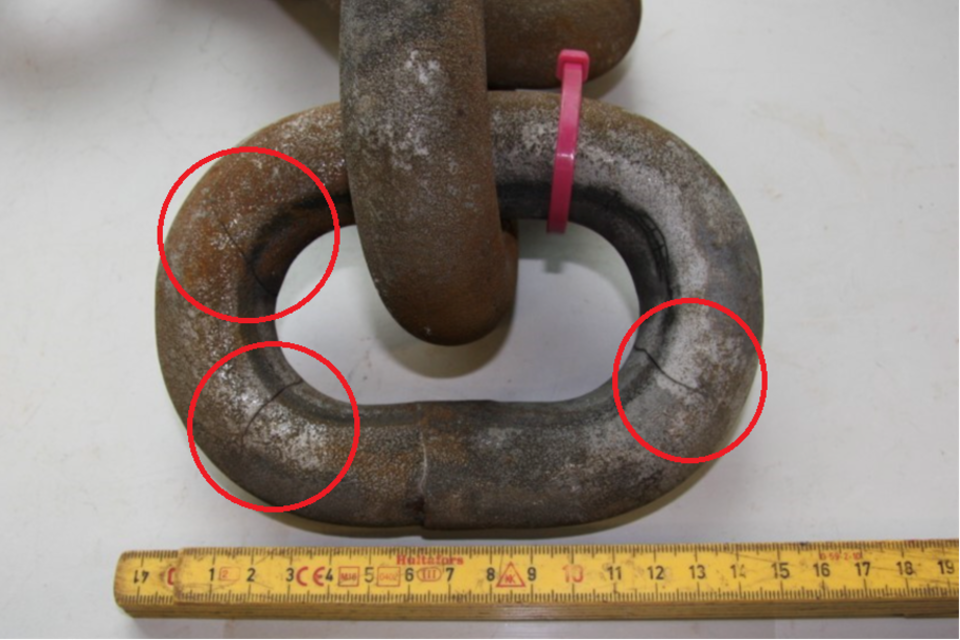Safety Bulletin 20: Safety concern over lifting equipment inspections on fishing vessels
Published 20 August 2021
Summary of issue
Following on from Safety Bulletin 17 issued in October 2020, the Maritime and Coastguard Agency are issuing this safety bulletin, following a number near misses, accidents, and a fatality to remind owners, employers, skippers and crew of UK fishing vessels of their responsibilities during lifting operations. This bulletin should be read in conjunction with Safety Bulletin 17.
Although applicable to all fishing vessels it is beam trawlers and scallop dredgers that are of immediate concern.
It is a requirement of the Merchant Shipping and Fishing Vessels (Lifting Equipment and Lifting Operations Regulations) 2006 (SI 2006/2184) that the owner / employer shall ensure all lifting equipment is thoroughly inspected, as a minimum, at 12 months with regular inspections in between.

Figure 1 A chain link used in the lifting equipment of a fishing vessel showing fractures identified during inspection.
Depending on the findings of the Company risk assessment, in certain applications, the frequency of inspection may need to be increased.
Specifically, the attention of the inspection regime, established by the owner, may need to be increased in areas of high load, high wear rates and high impact.
Examples of high load, high wear and high impact areas includes all fishing gear, its lifting apparatus, chains, wires and pulleys – typical of that found on beam trawlers and scallopers.
It is the owner’s / employer’s responsibility to ensure that sufficient technical information is provided to the competent person[footnote 1] to enable appropriate assessment of the in-service operation and the limits of acceptance of each item.
Where equipment is being assessed for continued service, the items should be appropriately cleaned – sufficient for a proper assessment to be made.
Where novel, new or modified equipment is placed into service, the owner has an obligation to ensure that the equipment is used in accordance with the manufacturer’s instructions and according to the inspection regime. For the avoidance of doubt, the manufacturer or supplier should be consulted about the intended use of the lifting equipment.
Lifting equipment or an accessory for lifting that is exposed to conditions causing deterioration which is liable to result in dangerous situations should be inspected by a competent person. This should be maintained at suitable intervals to ensure that health and safety conditions are maintained and that any deterioration can be detected and remedied in good time. The results of these inspections may lead the owner to consider inspection intervals being reduced.
Any deficient item of lifting equipment should be removed as soon as it has been identified as being potentially deficient.
Actions to take
Owners, operators, skippers, crew and safety advisors should ensure vessels under their control:
- Have an inspection regime sufficient to inspect all items of lifting equipment including those likely to be subject to high load, high wear and high impact;
- Have provided the competent person sufficient opportunity under appropriate conditions to be able to make an assessment for continued operation – which may require inspection techniques other than visual;
- Have determined the parameters within manufacturer’s recommendations for continued acceptance of items of lifting equipment;
- Have determined the frequency of inspection, and where the risk indicates possibility of premature failure, to increase the frequency of inspection in accordance with the Regulations;
- Have a system to record all inspections and changes to lifting equipment.
Owners shall ensure that their obligations under ILO 188 has been met in providing their crew with a safe place of work.
Further information
Safety bulletin 17: Safety concern over lifting operations on fishing vessels
-
A competent person is someone who is appropriately trained and has sufficient technical knowledge or experience to enable them to undertake the requirements of the Regulations. It is the duty of the owners & employers covered by these rules to satisfy themselves that persons are competent to carry out the work involved. ↩
